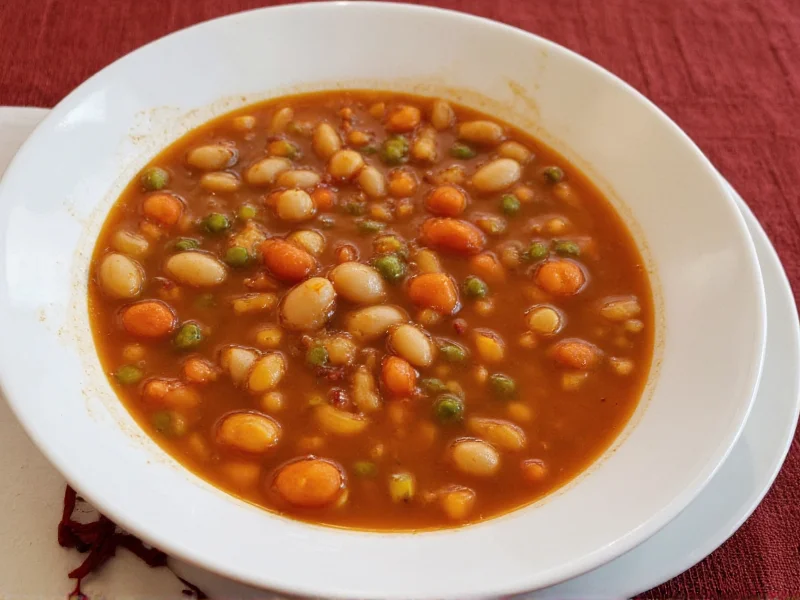Rooted in Italy's cucina povera ("poor kitchen") tradition, Italian bean soup transforms humble ingredients into nourishing meals. This rustic preparation reflects regional variations across Italy—from the garlic-and-rosemary-infused soups of Tuscany to the tomato-enriched versions found in central regions. The dish exemplifies Italian culinary philosophy: maximizing flavor through technique rather than expensive ingredients.
The Cultural Significance of Italian Bean Soup
Historically, Italian bean soup sustained farming communities through harsh winters. In Tuscany, it evolved into fagioli all'uccelletto, where beans simmer with sage and tomato. Umbrian versions often include wild herbs foraged from the countryside. These regional adaptations showcase Italy's culinary diversity while maintaining the soup's essential character—a thick, bean-centric preparation that requires no meat for depth of flavor.
Essential Ingredients for Authentic Flavor
The magic of traditional Italian bean soup lies in ingredient quality and preparation technique. Key components include:
- Cannellini beans - These creamy white beans form the soup's foundation. Dried beans preferred over canned for superior texture
- Soffritto base - Finely diced carrots, celery, and onion sautéed in olive oil
- Aromatic herbs - Fresh rosemary, sage, or thyme added during simmering
- Acid component - A splash of red wine vinegar or lemon juice to brighten flavors
- Finishing oil - High-quality extra virgin olive oil drizzled before serving
| Nutrient | Amount | Daily Value |
|---|---|---|
| Calories | 285 | 14% |
| Protein | 15g | 30% |
| Fiber | 12g | 48% |
| Iron | 4.2mg | 23% |
| Vitamin C | 18mg | 20% |
Step-by-Step Preparation Guide
Creating authentic Italian bean soup requires attention to technique rather than complexity. Follow these steps for restaurant-quality results at home:
- Soak dried beans overnight in cold water with a pinch of baking soda (helps digestion)
- Prepare soffritto by slowly cooking diced vegetables in olive oil until translucent
- Add soaked beans with fresh water or light vegetable broth (never salted water during cooking)
- Simmer gently for 60-90 minutes until beans are tender but intact
- Add tomatoes (if using) during the last 30 minutes of cooking
- Finish with herbs and a splash of vinegar to enhance flavor complexity
- Emulsify by mashing some beans against the pot wall for natural creaminess
Regional Variations Worth Trying
Italy's regional diversity creates fascinating adaptations of this simple dish:
- Tuscan Style - Features garlic, rosemary, and a splash of red wine vinegar. Often includes kale or cavolo nero
- Umbrian Version - Incorporates wild fennel and porcini mushrooms for earthy depth
- Southern Italian - Adds tomatoes and red pepper flakes for brightness and heat
- Vegan Adaptation - Omits pancetta, using smoked paprika for umami depth
Perfect Pairings and Serving Techniques
Traditional Italian bean soup achieves its full potential when served properly. For authentic presentation:
- Use wide, shallow bowls to showcase the soup's texture
- Drizzle with high-quality extra virgin olive oil just before serving
- Sprinkle with freshly grated Pecorino Romano (or vegan alternative)
- Accompany with crusty bread for dipping, not croutons
- Pair with a medium-bodied Chianti or Sangiovese wine
Storage and Reheating Best Practices
Italian bean soup improves with time as flavors meld. Follow these storage guidelines:
- Cool completely before refrigerating in airtight containers
- Refrigerate for up to 5 days or freeze for 3 months
- Reheat gently over medium-low heat, adding water if needed
- Restore freshness with a splash of lemon juice after reheating
- Never boil reheated soup—this breaks down bean texture
Frequently Asked Questions
What's the difference between Italian bean soup and minestrone?
Italian bean soup focuses primarily on beans as the star ingredient with minimal vegetables, while minestrone contains a wider variety of vegetables, pasta or rice, and often multiple bean types. Bean soup has a thicker, creamier consistency compared to minestrone's brothier texture.
Can I make authentic Italian bean soup without meat?
Absolutely. Traditional Italian bean soup often omits meat entirely, relying on aromatic vegetables, herbs, and high-quality olive oil for flavor depth. Many authentic versions are naturally vegetarian, with umami coming from slow-simmered beans and a splash of red wine vinegar added at the end.
Why shouldn't I add salt while cooking beans?
Adding salt during cooking can cause bean skins to toughen and prevent proper softening. Instead, season Italian bean soup with salt only after beans have fully softened—typically during the last 15 minutes of cooking. This technique ensures perfectly tender beans with creamy interiors.
How do I achieve the creamy texture without dairy?
Traditional Italian bean soup achieves creaminess through technique, not dairy. Mash a portion of the cooked beans against the pot wall using a wooden spoon, or remove 1-2 cups of soup and blend briefly before returning to the pot. This releases the beans' natural starches, creating a velvety texture without any dairy products.
Which beans work best for authentic Italian bean soup?
Cannellini beans are the traditional choice for Italian bean soup, prized for their creamy texture and mild flavor. Borlotti (cranberry) beans also work well in central Italian versions. Always use dried beans rather than canned for superior texture and flavor absorption—canned beans often become mushy during simmering.











 浙公网安备
33010002000092号
浙公网安备
33010002000092号 浙B2-20120091-4
浙B2-20120091-4